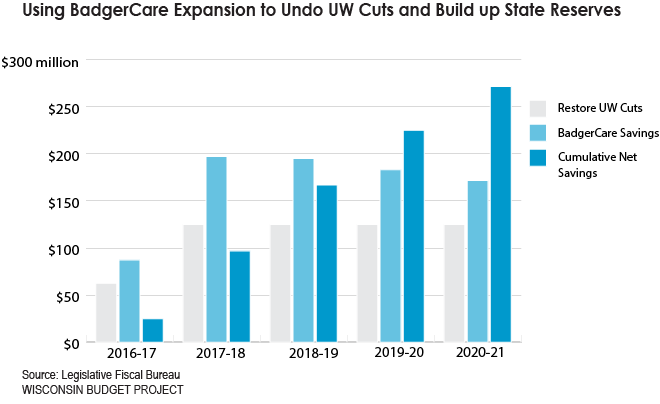$1 Billion Savings In Six Years
If expanded federal Medicaid money accepted. But some legislators dispute LFB analysis.
The Legislative Fiscal Bureau (LFB) has calculated that expanding BadgerCare and thereby qualifying for a higher federal reimbursement rate would yield huge savings for Wisconsin.
The most recent LFB analysis, issued last December, examined the effects of boosting the BadgerCare income limit for adults to 133 percent of the federal poverty level (FPL) from 100 percent of FPL now (which amounts to just $7.70 per hour for single parent with one child). The LFB concluded:
- Initiating that change in January 2016 would have saved state taxpayers $323.5 million during the 2015-17 biennial budget period, while covering an additional 83,000 adults.
- The state would have netted nearly $1 billion in savings over a six-year period
- A one-year delay in the expansion would reduce the savings by $236 million, but Wisconsin would still save an average of more than $15 million per month once the change took effect.
Opponents of expansion haven’t directly challenged those estimates. That’s smart strategically, as you will rarely help your position by disputing a careful, nonpartisan analysis by the Fiscal Bureau’s Medicaid experts.
However, a couple of legislators with a history of opposing expansion now appear to be trying to indirectly undercut the projected cost savings. They contend that some other states have not experienced savings through expansion, which shows that Wisconsin made the right decision to set the BadgerCare income limit at a lower level that does not qualify our state for the increased federal reimbursement rate.
To support their argument, they have looked to states like Ohio, which expanded Medicaid and have experienced higher participation rates than they anticipated. That argument fails to account for two important ways in which Wisconsin is in a much different position than states like Ohio:
- Wisconsin already has experience with higher eligibility levels – The BadgerCare income limit for parents was initially set at 200 percent of the federal poverty level (FPL) when Governor Thompson and legislators launched BadgerCare in 1999, and the income cap remained at that level until it was cut to 100 percent of FPL in 2014. As a result, the Fiscal Bureau has a good handle on what the parent participation would be if we increased eligibility to an intermediate level, 133 percent of FPL, to qualify for the increased federal funding.
- In a partial expansion state, higher–than-anticipated enrollment makes qualifying for the federal funds even more beneficial – Wisconsin’s expansion of BadgerCare eligibility for childless adults to the poverty level in 2014 resulted in a much larger enrollment increase among those adults than expected, and the state pays about 42 percent of the costs of covering those adults. By increasing eligibility a little further, the state share would drop sharply (to no more than 10%). As a result, after Wisconsin experienced higher-than-anticipated enrollment of childless adults, the LFB significantly increased its estimate of the net savings that could be realized by a larger expansion that would qualify our state for the much higher federal reimbursement.
Another flawed argument opponents sometimes make against expansion is that, because the full federal funding for childless adults would gradually decline to a 90 percent match rate, a structural deficit in future years is possible. As I wrote in a previous post, that’s like turning down the opportunity to refinance your mortgage if you learned that the initial savings of $100 per month would decline over a few years to $90 per month.
The LFB memo indicates that even after the federal match rate declines to 90 percent (well above the current 58% rate), Wisconsin would still save an estimated $171.6 million per year in 2021 and beyond. The fact that the savings would gradually decline is not a logical reason to oppose expanding BadgerCare; it’s a reason to plan ahead and use the savings prudently.
The following graph shows the fiscal effect of expanding BadgerCare to 133 percent of FPL next January, and at the same time using part of the savings to undo the $125 million per year cut to the UW System. The graph illustrates that if lawmakers put aside the remainder of the savings, state budget reserves would grow by $271 million over the next five fiscal years.
The LFB is a trusted resource for Wisconsin and they are very prudent and thoughtful in their analysis. I’m confident that if legislators ask the Fiscal Bureau to use new data – based on the most recent enrollment trends in Wisconsin and the experience in other states – the LFB will take the latest numbers into account and once again conclude that expanding BadgerCare would yield a very large net savings.
I commend these legislators for engaging in a debate about the costs and potential savings of Medicaid expansion and what we can learn from empirical evidence. It’s exactly the kind of debate we will need to have over the next year as Wisconsin faces serious budget challenges. If legislators look honestly and without bias at the data, they will see the substantial savings from a modest expansion of BadgerCare.
Wisconsin Budget
-
Charting The Racial Disparities In State’s Prisons
 Nov 28th, 2021 by Tamarine Cornelius
Nov 28th, 2021 by Tamarine Cornelius
-
State’s $1 Billion Tax Cut Leaves Out 49% of Taxpayers
 Sep 21st, 2021 by Tamarine Cornelius
Sep 21st, 2021 by Tamarine Cornelius
-
TANF Program Serves a Fraction of Poor Families
 Aug 30th, 2021 by Jon Peacock
Aug 30th, 2021 by Jon Peacock




















